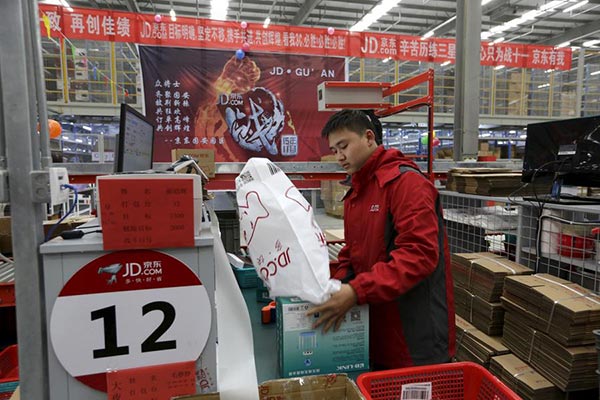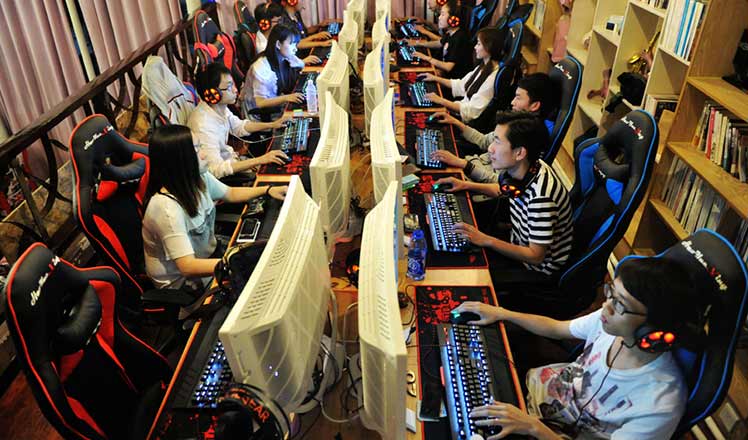The making of China's consumer society
Updated: 2016-09-05 07:27
By Andrew Sheng and Xiao Geng(China Daily)
|
||||||||
 |
|
An employee works at a JD.com logistic centre in Langfang, Hebei province, November 10, 2015.[Photo/Agencies] |
China's transformation from a manufacturing-driven and export-led economy to one underpinned by services and domestic consumption is firmly underway. And that's good news not just for China, but also for the future of the global economy.
The 2016-17 edition of the Blue Book of China's Commercial Sector by Fung Business Intelligence and the Chinese Academy of Social Sciences maps the change. China's retail markets reached 30 trillion yuan ($4.6 trillion) in 2015, after more than a decade of double-digit growth. Household consumption has begun to climb, even as the pace of investment has fallen, and now exceeds 6 percent of GDP. Though the consumption growth rate has slowed to 10.7 percent, the Blue Book projects that China's domestic market may reach 50 trillion yuan by 2020.
A key driver of this transformation has been internet technology. Building on heavy investments in public infrastructure, such as ports, airports, roads, railways, and telecommunications, the internet is now expanding rapidly the range of choices available to Chinese consumers, while lowering costs and accelerating delivery.
As a result, China's online retail sales have surged in recent years, from 6.3 percent of total retail sales in 2012 to 12.9 percent by 2015. By 2020, 40 percent of all retail transactions in China may be conducted online. Online sales via mobile phones have jumped from only 1.5 percent in 2011 to 55.5 percent in 2015, and may reach 73.8 percent by 2018.
China has now overtaken the United States to build the world's largest online retail market. With a growth rate of some 33 percent, it is also the fastest-growing such market. And despite growth in internet use-the number of connected Chinese has risen from 253 million in 2008 to 688 million last year-there is plenty of room for further expansion.
This progress reflects innovations that enable broad-based consumption without the construction and maintenance of expensive brick-and-mortar outlets. In fact, growth in mobile sales has been driven by lower-income consumers, particularly in rural areas, where more than 81 percent of internet use occurs via mobile devices.
One key innovation has been multi-sided platforms like Alibaba, which, by providing access to production, logistics, distribution, and payments, challenge traditional business models-with considerable success. In the second quarter of 2016, Alibaba announced that its revenue from China's retail market had increased by 49 percent year-on-year; another online platform, Tencent, reported a 52 percent increase.
By connecting small and medium-sized enterprises (which account for 80 percent of employment in China) with the consumer base, such platforms erode some of the competitive advantage of large State-owned enterprises. Indeed, while the returns from China's internet retailing revolution have been highly concentrated, for once this concentration has not been in the State sector.
In online retailing via mobile devices, Alibaba held an 84.2 percent share of the market last year, with the next largest online retailer, JD.com, capturing just 5.7 percent. In the business-to-consumer market, Alibaba's Tmall claimed a 58 percent market share in the third quarter of 2015, with JD.com taking just 22.9 percent. In third-party online payment services, Alipay held 47.5 percent of the market, while Tenpay captured 20 percent, and UnionPay, the only service developed by the banking community, had 10.9 percent.
- Over 700 Chinese companies take part in 2016 IFA consumer electronics fair
- Consumer-driven firms forge ahead in H1
- Consumer goods' quality to improve
- Consumer confidence, convenience really matter in online trade
- Top 10 largest consumer goods companies worldwide
- Ecommerce brings new business, opportunities to China Commodities City
- Rousseff appeals impeachment to Supreme Court
- Europeans displeased with their education systems
- Singapore Zika cases top 150; China steps up arrivals checks
- Artists respond to 9/11 attacks in new exhibit
- Rocket explodes on launch pad in blow to Elon Musk's SpaceX
- Record number of Americans dislike Hillary Clinton: poll

 Commemorative G20 stamps a hit at media center
Commemorative G20 stamps a hit at media center
 Ten photos from around China: Aug 26- Sept 1
Ten photos from around China: Aug 26- Sept 1
 Hangzhou: Paradise for connoisseurs of tea
Hangzhou: Paradise for connoisseurs of tea
 Top 10 trends in China's internet development
Top 10 trends in China's internet development
 Childhood captured in raw, emotive black and white
Childhood captured in raw, emotive black and white
 Korean ethnic dance drama shines in Beijing
Korean ethnic dance drama shines in Beijing
 Children explore science and technology at museum
Children explore science and technology at museum
 Children wearing Hanfu attend writing ceremony
Children wearing Hanfu attend writing ceremony
Most Viewed
Editor's Picks

|

|

|

|

|

|
Today's Top News
Trump outlines anti-terror plan, proposing extreme vetting for immigrants
Phelps puts spotlight on cupping
US launches airstrikes against IS targets in Libya's Sirte
Ministry slams US-Korean THAAD deployment
Two police officers shot at protest in Dallas
Abe's blame game reveals his policies failing to get results
Ending wildlife trafficking must be policy priority in Asia
Effects of supply-side reform take time to be seen
US Weekly

|

|









